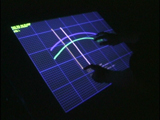The Missing Detail of of New Human Machine Interfaces
 By now just about everybody is ooh-ing and aww-ing over this demonstration video showing multiple users on a single touch and pressure sensitive graphical user interface.
By now just about everybody is ooh-ing and aww-ing over this demonstration video showing multiple users on a single touch and pressure sensitive graphical user interface.
And rightfully so. This thing is amazing! Who wouldn’t want to be able to organize their photos in the manner they do in the demo? They’ve created a particularly intuitive means for navigating photos, maps, floating lava lamp blobs that is a huge step forward in usability.
Is it Ergonomic?
But there was one small issue that popped in the back of my mind. One other detail that would need to be addressed by such an interface. Is it ergonomic?
For software developers, who typically sit at a computer 8 or more hours a day, the ergonomics of a system are extremely important. Ideally monitors are placed so that the top is a couple of inches above eye level. Your head actually has a significant amount of mass (even more if you have a forehead like mine) so it should remain for the most part balanced on your neck to prevent strain.
What would eight hours a day looking down at a tilted screen do to a person’s body? Either we would develop very strong neck and shoulder muscles like our governator, or we would suffer from shoulder and neck pains along with headaches.
I am not sure what the solution is, but I hope they address it because I definitely would want such a device. Perhaps one option is a dual screen approach where a user could alternate by looking at a non-tactile screen at eye level that mirrors what the user is doing on the touch screen, allowing the user to alternate between screens. Having the touch screen at eye level would only introduce upper arm and shoulder pain. Ever try holding your arms straight in front of you for hours at a time? It is painful. Whatever the solution, I bet they will come up with something better than anything I have proposed.
The Lesson
The lesson here is that great design is hard and there is no perfect design. When trying to design anything, such as a new UI, a compensation plan, etc… You have to consider and try to anticipate unintended consequences.
Comments
4 responses